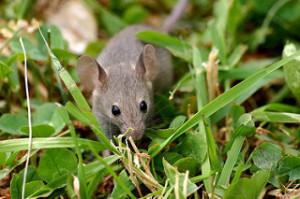Do Your Doors Need to Be Pest-Proofed?
By Chris Williams on August 12, 2015.

Just like people, mice and rats commonly use doors to enter buildings, but they typically go under them rather than through them. Certain outdoor insects and other arthropods such as crickets, cockroaches, and millipedes frequently get into lower levels through faulty doors. To pest-proof a door, you can install door sweeps and thresholds at the bottom, along with weather seals or weather stripping around the sides and top.
If the distance between the bottom of the door and the threshold is more than ¼ inch, a mouse can get through it and you need a tight-fitting door sweep. Door sweeps range from vinyl or rubber strips, to a simple nylon brush on a screw-on strip, to more elaborate brushes that are enclosed in a metal threshold. There are even automatic door sweeps that drop down and seal into place when the door is closed.
Weather stripping around a door seals the sides and top as well, eliminating even more gaps to keep pests out. Weather stripping is available in many varieties including wrapped foam flange, foam tape, rubber, vinyl, felt, and metal compression strips. You can purchase door sealing kits that include a header seal, jamb seals, and door bottom seals.
Garage doors are a common (and often overlooked) entry point for mice and other pests (see Maintain Your Garage Door to Keep Mice Out). Rubber garage door gaskets don’t last forever. There is almost always a space at the bottom corners of a garage door where the door seal has worn and no longer meets the side frame. Older garage doors should be fitted with new compression seals and strips.
Added Benefits of Pest-Proofing Doors
In addition to stopping pests, pest-proofing doors also stops smells, light, and heat that emanate from the door, all of which attract pests. When you pest-proof doors, you are also weather-proofing, sound-proofing, and insulating – all at the same time that you are stopping pests. Energy costs are lowered by maintaining the indoor temperature and keeping the weather and drafts out. Noise is reduced from outside to inside and room to room. And finally, by reducing pests inside, sealing and weather-proofing of doors reduces the amount of pesticide used in your home.
Who You Gonna Call?
You can do the pest-proofing work yourself, or you can contract out. Some pest control companies, like Colonial, also do pest-proofing as part of a pest management program. The advantage in having a pest control company do this work rather than a general contractor is that we know pests, we know their habits, and we recognize the types of openings that let pests inside. It’s our job to keep them out. Give Colonial Pest a call today and ask about our pest-proofing services.